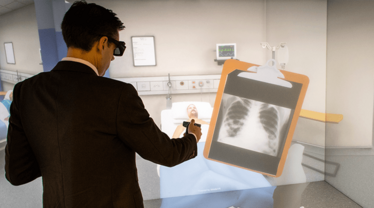Experiencing the KAVE
Our Associate editor, James Strachan, takes a trip to the UK’s Keele University to find out how virtual reality is revolutionizing education and training

A popular use of virtual reality is a “CAVE” – a cave automatic virtual environment. Projectors are directed at the walls of a room to create an immersive virtual reality world – and it has many uses. A number of engineering companies have incorporated CAVEs into their product development processes, for example; and researchers from the University of Calgary, US, have used the technology to simulate disease progression (1).
Keele University’s School of Pharmacy have developed their own version of a CAVE, called “KAVE” (Keele Active Virtual Environment) – a three-dimensional computer-simulated learning environment(2). I paid the team to a visit to find how it’s used and to try it out for myself.
As I stepped into the KAVE and donned the virtual reality glasses, I found myself at the foot of a patient’s bed. The graphics weren’t cutting edge, but the fact that the patient’s eyes followed me about the room as I moved made the experience far more real than I’d expected.
The idea behind the KAVE is to train pharmacy students in an environment as close to the real one as possible. “The role of the pharmacist is changing – it’s much less about supplying the pills and much more about clinical decision making and teamwork," Stephen Chapman, Professor and Deputy Head of the Keele School of Pharmacy explained to me.
The KAVE allows pharmacy students – as well as those studying medicine and nursing – to react to simulated scenarios. As I explored the KAVE's virtual ward using a joystick, a patient in a bed to my left suddenly curled over in pain and I could see his heart monitor going haywire. Here, students would be expected to deal with the situation, in their respective roles, just as they would in real-life – and because students wear glasses (rather than headsets) they are still able to interact with each other. “It takes students very little time to forget they’re dealing with a machine,” says Chapman. “We’ve had students cry in the KAVE, we’ve had students get angry with the avatar – I've even had a student complain that the avatar had been rude to them!”
I was also shown how the KAVE can be used to generate 3D molecules, which you can walk around, zoom in on, and manipulate using the joystick. “There’s a potential here for research,” says Chapman. “If you want to look at how a complex molecule might interact with molecule X, Y and Z, it’s a fairly cost-effective way of doing so because you can download any molecule you want from the Protein Data Bank.”
Chapman’s team is also developing virtual patient information apps that can be downloaded to any mobile device. Patients can then use the app in a number of different ways; for example: to view an asthma inhaler technique, to be reminded about taking a medication, to find out what a condition, such as chronic obstructive pulmonary disease, actually looks like and how a certain activity might affect the condition, to visualize the concept of risk through an animation, and so on.
In fact, one pharma company has commissioned the team to develop an app to train and test medical reps with virtual sales consultations, where they have to stay within the UK’s ABPI (Association of the British Pharmaceutical Industry) code of practice.
“My view is that in science teaching virtual reality is going to become the norm,” says Chapman. “Certainly, in medicines and pharmacy I can’t see us proceeding without it.”
Having experienced the KAVE for myself, I tend to agree – and I understand how some students become a little too immersed in its virtual reality world (it’s the eyes!). But as Chapman explained to me, it isn’t just that VR can provide a simulation of a real ward, it’s also the fact that the experience can be standardized and made consistent. It seems to me educators should think twice before dismissing VR as a gimmick or something for the distant future – it’s already here and I can’t see it going away.
- University of Calgary, “U of C scientists unveil the virtual human”, (2016). Available at: bit.ly/2gqA0iL. Last accessed November 18, 2016.
- SR Chapman and L Bracegirdle, “Simulation and consultation skills for virtual environment”, BAMS, 6, 111-115 (2016).

Over the course of my Biomedical Sciences degree it dawned on me that my goal of becoming a scientist didn’t quite mesh with my lack of affinity for lab work. Thinking on my decision to pursue biology rather than English at age 15 – despite an aptitude for the latter – I realized that science writing was a way to combine what I loved with what I was good at.
From there I set out to gather as much freelancing experience as I could, spending 2 years developing scientific content for International Innovation, before completing an MSc in Science Communication. After gaining invaluable experience in supporting the communications efforts of CERN and IN-PART, I joined Texere – where I am focused on producing consistently engaging, cutting-edge and innovative content for our specialist audiences around the world.



















